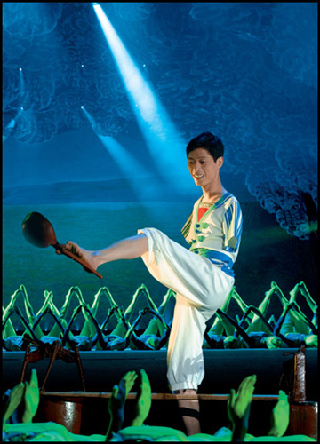DIFFICULT ART
In "My Dream," Huang's dance presents a picture of rural life in his hometown with exuberance and joy. He skillfully carried two buckets with a pole on his shoulders, holds a ladle between the toes of one foot, while standing on the other.
He also spun a straw hat on his head to celebrate harvest. Nothing sad.
 |
|
Huang Yangguang, an armless lead dancer with the China Disabled People's Performing Art Troupe, performs in "My Dream" in this undated file photo. [Ggodpp.gov.cn]
|
The same vigor was conveyed by other programs of the show, which was updated for the fifth time for the Beijing Olympics and Paralympic occasions and put on in Beijing during the respective Games.
In the two-hour show, two hearing-impaired actors performed Peking Opera while their blind companions played music and voiced the dialogue. A group of blind dancers paid tribute to spring. A band without music books plays, despite its members being unable to see.
"Communication and cooperation between our members is natural," Tai said. "Of course it's more difficult for us than for others, but everyone here has been used to his or her environment. That's the way we live, so we try harder."
The 32-year-old Tai lost her hearing from excessive medicine injections during a bout of fever at age two. She had to count from one to eight in her head more than 1,000 times to complete a dance without messing the rhythms.
The dancer overcame her disability, making a hit out of her performances at such top-class venues as New York's Carnegie Hall and Milan's La Scala Theater.
She first "heard" music at the age of seven, when she had a rhythmic class at a primary school for deaf-mutes.
"When I felt the drum beats passed on to my feet through the wood floor, I was startled. It was a happiness I had never experienced." Since then, she had never looked back on her dancing journey.
Like Tai, all members of the troupe had to fully realize their potential and turn to some special means to fulfill artistic achievement.
In a dance celebrating spring, blind boys and girls wearing sunglasses kept themselves in a neat line helped by a rope tied to their waists. Arm in arm, they put together green plastic patches to form a patch of grassland and smiled while sniffing the grass.
"It was very difficult as sight-impaired people had no sense of images and usually made vocal performances," said an ex-official with the China Disabled Persons' Federation (CDPF), which was in charge of the troupe.
"The choreographer came up with the idea as we wanted to give our audience something special, something that nobody would think was possible," she said.
To give the blind dancers a basic idea of body movement, the teacher made a pose first and then let them feel the position of her arms and legs.
"Many blind kids didn't even know what a smile is," said the official, who had been working closely with the troupe since its establishment and spoke on condition of anonymity. Like Tai, the troupe authorities always called the members "kids" in affection.
Some could only make awkward expressions or simply laugh when told to smile, she said. The teacher had to use hands to fix a smile on their faces and asked them to remember the muscle movement.
Their work paid off. The elegant, bright smiles were infectious and always enlivened audiences.

